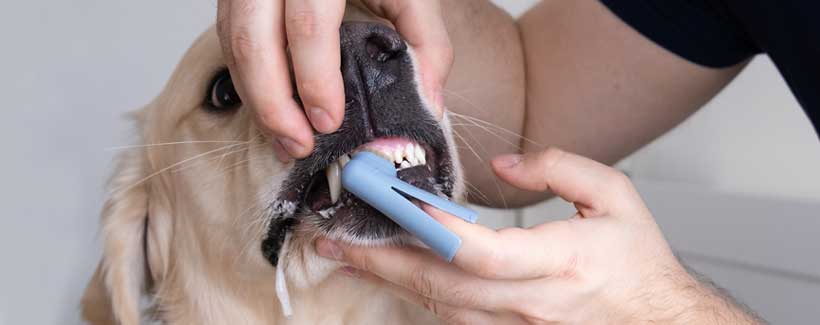
Brushing Your Dog’s Teeth; Tips for Success – Well Pet Blog
Posted February 18, 2021 in Grooming

Daily teeth cleaning between your dog’s regular dental exams is an essential step in grooming your dog as brushing removes plaque, promotes fresh breath, and maintains or improves their overall health. The removal of plaque prevents serious problems of tooth decay or gum disease. Plaque is a sticky substance of bacteria which results from food caught in teeth, bacteria found in the mouth, and proteins found in your dog’s saliva. Removal of plaque requires brushing or scraping your dog’s teeth. If not removed from dog’s teeth, plaque can harden and calcify into tartar within 48-72 hours and tartar removal requires a professional cleaning at the vet.
What are the training steps for your dog’s acceptance of brushing teeth? Are there any tips for success? The key principle is the handling of your dog to help them accept brushing teeth with ease. Begin by choosing a time when your dog is calm, a location with good lighting, and offer a pleasant experience with attention, love, and treats. Be realistic if you meet resistance, you possibly are going too fast, so stop for the day and try again tomorrow. Consistency, patience, and repetition from you are important factors for success to make brushing your dog’s teeth an accepted routine. Positive reinforcement and treats given during the training session help your dog by positive association that brushing teeth is good and results in praise and rewards.
How to train your dog to accept brushing.
- Start the training session slow, by just having your dog sit still a few seconds and then give a treat.
- Lift the dog’s lip on the left side and give another treat.
- Rub the dog’s gums on left side with your fingers and offer a treat.
- Lift the right side of upper lip and pulling bottom lip down, repeat rubbing dog’s gums and touching teeth.
- Take the process slow co you don’t frighten your dog and if they pull away, stop, and try again later. Repeat these training steps once a day for several days. At this point the goal is not to clean teeth but simply get your pet used to the activity.
How to brush your dog’s teeth.
After several days of practice initiate cleaning dog’s teeth. Do only one quarter of the teeth first day, another quarter the next day and repeat this practice until all quarters have been brushed. It may be several weeks before the entire mouth can be done in one cleaning. This gradual process is the most effective in introducing teeth brushing to your pet. Now for the steps in brushing your dog’s teeth.
- Initial brushings may work best using only your finger with toothpaste on it. There are several toothbrush styles made commercially for dogs. Depending on the size of the dog, and your skillfulness, using a finger toothbrush that fits over your fingertip may be the best choice.
- When you are ready to introduce the toothbrush let your dog lick the toothpaste off the brush or on your fingertips so they can get used to texture and taste. If at any time they refuse to lick toothpaste after the first taste, try a different flavor until one is found that they like, helping your dog accept the toothpaste as a treat.
- Touch the teeth on top and bottom and reward your dog with praise and a treat for being a good student.
- Start with the top teeth first as they are easy to reach. Make sure you have toothpaste on your toothbrush. Raise the upper lip up and hold toothbrush at a 45-degree angle against your dog’s teeth so the bristles massage the gum line and remove plaque and start brushing the front teeth.
- Brush front teeth in small circles moving from top to bottom. Light bleeding may happen occasionally when brushing gums and this should be ok. If bleeding becomes constant or heavy, you are brushing to hard, or it could be a sign of gum disease and you should consult your vet. If brushing side of teeth is causing anxiety in your dog, stop, give praise, and a treat. Remember go slow.
- Brush the bottom teeth by holding down bottom lip, again start brushing the front teeth first in a circular motion from top to bottom. Then move to the side and back. Again, go slow if any signs of anxiety appear in your dog when moving to side teeth, stop. Repeat the praise and reward. Once your dog is calm you can resume brushing the side teeth.
Brushing your dog’s teeth is the best method to keep clean and remove plaque. There are additional products to use if unable to brush on a regular basis. Other dog dental care products include water additives, wipes, gels, sprays, and dental chews.
If you have any questions or are nervous about cleaning your dog’s teeth by the brushing process, or if your dog has never had their teeth cleaned it is beneficial to schedule a dental check up with your veterinarian first. Ask your vet tech or veterinarian any dental health questions or techniques to aid the success of training your dog to accept brushing.

